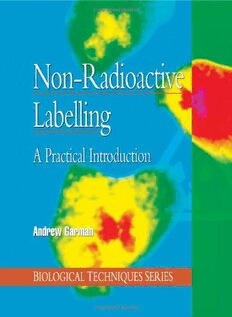Download Non-radioactive labelling: a practical introduction PDF Free - Full Version
Download Non-radioactive labelling: a practical introduction by A. J. Garman in PDF format completely FREE. No registration required, no payment needed. Get instant access to this valuable resource on PDFdrive.to!
About Non-radioactive labelling: a practical introduction
Biological Techniques is a series of volumes aimed at introducing to a wide audience the latest advances in methodology. The pitfalls and problems of new techniques are given due consideration, as are those small but vital details not always explicit in the methods sections of journal papers. In recent years, most biological laboratories have been invaded by computers and a wealth of new DNA technology and this will be reflected in many of the titles appearing in the series. The books will be of value to advanced researchers and graduate students seeking to learn and apply new techniques, and will be useful to teachers of advanced undergraduate courses involving practical or project work. Labelled biomolecules are an essential tool in life science research, and non-radioactive labels are becoming increasingly important due to their convenience of measurement, greater safety and lack of disposal problems compared to radioactive labels. This book provides practical information, background theory and protocols to allow a beginner to label many types of biomolecules, including proteins, peptides, nucleic acids and small molecules. This book is essential for biochemists, molecular biologists and cell biologists wanting to use non-radioactively labelled molecules. Key Features * Aimed at researchers without specific expertise in chemistry, the book includes: * A review of the main signal systems and labels available, indicating their strengths and weaknesses * Discussion of the most useful strategies for labelling the various biomolecules * 32 protocols covering common labelling needs * Descriptions of the factors governing protocol design, enabling protocols to be modified for different applications * Sources of information including references, data and suppliers
Detailed Information
| Author: | A. J. Garman |
|---|---|
| Publication Year: | 1997 |
| ISBN: | 9780122760457 |
| Pages: | 155 |
| Language: | English |
| File Size: | 8.275 |
| Format: | |
| Price: | FREE |
Safe & Secure Download - No registration required
Why Choose PDFdrive for Your Free Non-radioactive labelling: a practical introduction Download?
- 100% Free: No hidden fees or subscriptions required for one book every day.
- No Registration: Immediate access is available without creating accounts for one book every day.
- Safe and Secure: Clean downloads without malware or viruses
- Multiple Formats: PDF, MOBI, Mpub,... optimized for all devices
- Educational Resource: Supporting knowledge sharing and learning
Frequently Asked Questions
Is it really free to download Non-radioactive labelling: a practical introduction PDF?
Yes, on https://PDFdrive.to you can download Non-radioactive labelling: a practical introduction by A. J. Garman completely free. We don't require any payment, subscription, or registration to access this PDF file. For 3 books every day.
How can I read Non-radioactive labelling: a practical introduction on my mobile device?
After downloading Non-radioactive labelling: a practical introduction PDF, you can open it with any PDF reader app on your phone or tablet. We recommend using Adobe Acrobat Reader, Apple Books, or Google Play Books for the best reading experience.
Is this the full version of Non-radioactive labelling: a practical introduction?
Yes, this is the complete PDF version of Non-radioactive labelling: a practical introduction by A. J. Garman. You will be able to read the entire content as in the printed version without missing any pages.
Is it legal to download Non-radioactive labelling: a practical introduction PDF for free?
https://PDFdrive.to provides links to free educational resources available online. We do not store any files on our servers. Please be aware of copyright laws in your country before downloading.
The materials shared are intended for research, educational, and personal use in accordance with fair use principles.

